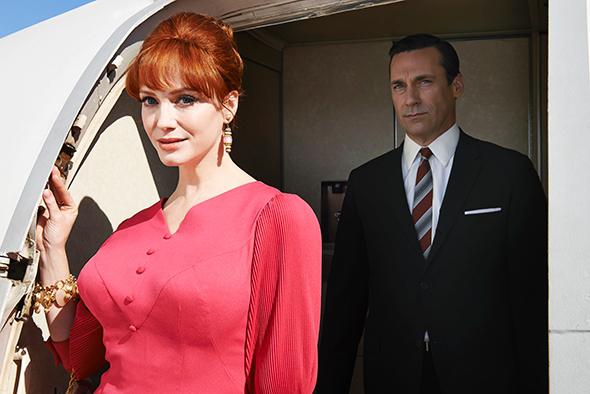Willa, Julia,
Last season opened with Don seen but not heard for the first seven minutes. This season, he didn’t even appear on screen for the first eight. If the trend holds, the string of episodes launching in 2015 will forget Don entirely until about Week 3.
When he did show up, Don was a man out of step with his era. It’s no coincidence the episode is titled “Time Zones.” We first see him shaving, achieving a clean-cut look that feels more 1959 than 1969. He then puts on his trademark hat with the feather in the band, which surely began going out of style shortly after the Beatles arrived in America. Later, we see him polish his clunky black shoes while watching Nixon on TV. It’s starting to feel like Don is part of the Silent Majority.
Furthering my impression that Don’s no longer at the center of the action: that tracking shot on the airport people mover. Don’s a passive rider, buoyed along by forces beyond his control. The shot’s an homage to the title sequence of The Graduate, which used it to suggest Benjamin Braddock’s similar lack of agency. (Though the colorful LAX tile mosaic behind Don reminded me that Quentin Tarantino employed the same trick for the title sequence of Jackie Brown.)
I was glad to see Don at least hasn’t lost his marketing mojo. The Accutron pitch—even coming, as it did, from the jowly mouth of Freddie Rumsen—was weirdly riveting. “This is the beginning of something,” Freddie intones (in a center-frame shot straight from the Wes Anderson playbook). Maybe Don’s not out of touch, after all? He still seems in tune with the 28-year-old business bros the campaign hopes to target.
If the late ’60s are leaving Don behind, they suit Joan just fine. Twice in a row, she encounters men who express negligible interest in her hillsides but fervently hope to draw on her professional wisdom. Are we taking a few baby steps forward in the realm of gender equity? Joan looks prepared to slide right into an account manager role, taking pressure off the beleaguered Ken Cosgrove. (In the land of the one-eyed executive, the one-earringed woman is queen.)
That Butler Footwear nerd who needs Joan’s help seems to portend a new era of professional responsibility/lameness: no alcohol. Home in time to tuck in the kids. This baby-faced fellow is also a harbinger of the MBA revolution: Quantification and synergy will soon be replacing gut feels and three-martini lunches.
Don seems cognizant of the shift. He’s pulling himself together, resisting booze, working hard even though he doesn’t have to. Willa, “I’m a Man” served as a jaunty musical cue, but as Don’s theme song, it’s more nuanced than it appears. Note the lyrics in the first verse: “I ain’t got no time for lovin’/ ’Cause my time is all used up/ Just to sit around creatin’/ All that groovy kind of stuff.” This is Don’s mantra now: When he turns down Neve Campbell’s advances, he claims it’s because he needs to get back to work. (By the way, is this all we’re getting of Neve? The woman who, in 1996, inspired me to go see The Craft the day it opened? It would be a legit tragedy if she’s one-and-done in the Mad Men universe.)
Mad Men is increasingly a tale of two cities. The show seems bent on exploring the origins of bicoastalism. (Or is it just that they film in L.A., which makes Matthew Weiner particularly attuned to the phenomenon, and also makes it easy to budget in some exterior shots?) I looked up the TV show Don watches at Megan’s house while she’s asleep on his shoulder: It’s a broadcast of Frank Capra’s Lost Horizon, which is about a plane that crashes in the Himalayas, depositing its passengers in Shangri-La. Those title cards speak of a yearning for Utopia, and I couldn’t help but recall Pete Campbell’s description of the snow-capped mountains near the Sunkist orange grove. Or Neve’s revelation that her husband’s ashes are scattered in Disneyland—a notion that visibly perked Don up. What is it with Don’s romanticization of La La Land?
Julia, I’m curious: If you were Peggy—striving to create transcendent work, but with a boss who settles for and even encourages mediocrity—how would you deal with the situation? Also, I’d love to hear what you made of that final sequence. Seemed like some heavy symbolism there, with Don helpless to shut out the world beyond his apartment and the cold air rushing in. The closing music was a 1967 cover by Vanilla Fudge of the Supremes’ “You Keep Me Hanging On”—and it left me asking, who needs to set whom free?
I don’t even care that you smell like incense,
Seth
Read all of Slate’s coverage of Mad Men.
